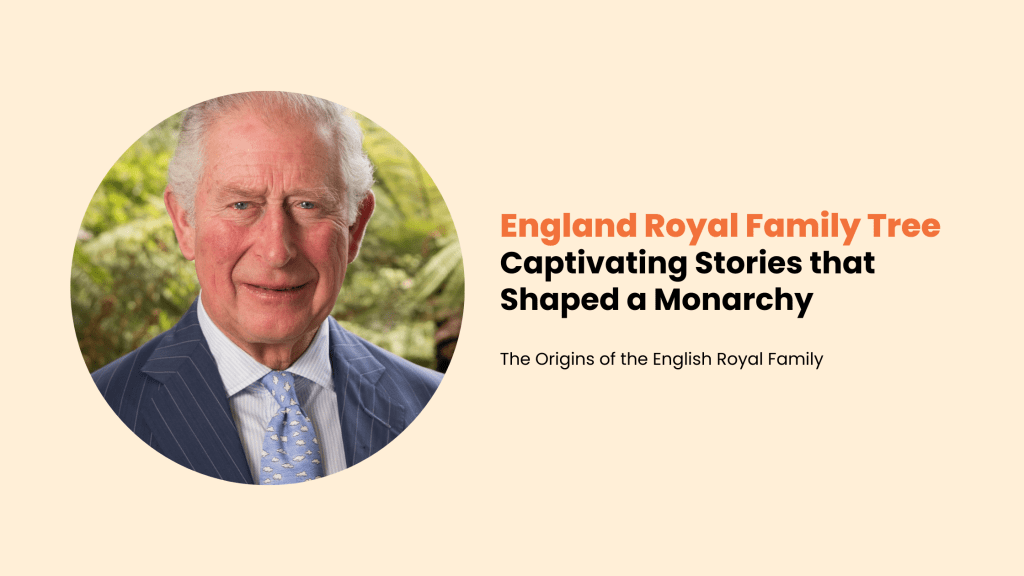The Origins of the England Royal Family Tree
The origins of the English royal family can be traced back to several different dynasties and historical periods, This blog post explores the history of the English royal family and explains their family tree in detail, Here’s a brief overview of the key origins of the England Royal Family Tree:
Anglo-Saxon Period (5th-11th centuries):
The English royal family traces its earliest roots to the Anglo-Saxon kingdoms that existed before the Norman Conquest. These kingdoms included Wessex, Mercia, Northumbria, and East Anglia. The most notable early English kings include Alfred the Great (871-899) and Athelstan (924-939).
Norman Conquest (1066):
In 1066, William the Conqueror, Duke of Normandy, invaded England and defeated King Harold II at the Battle of Hastings. This marked the beginning of Norman rule in England. William and his descendants established the House of Normandy, which included notable kings such as William II, Henry I, and Henry II.
Plantagenet Dynasty (1154-1485):
The Plantagenet dynasty, which originated from the House of Anjou, came to power with Henry II in 1154. This dynasty saw significant events such as the signing of the Magna Carta in 1215 during the reign of King John. The Plantagenets included renowned monarchs like Richard the Lionheart, Edward I, Edward III, and Richard III.
Tudor Dynasty (1485-1603):
The Tudor dynasty began with Henry VII, who won the Battle of Bosworth in 1485, ending the Wars of the Roses. This dynasty is best known for the reigns of Henry VIII, who broke away from the Catholic Church, and Elizabeth I, who oversaw a period of significant cultural and maritime expansion.
Stuart Dynasty (1603-1714):
The Stuart dynasty originated from Scotland and took the English throne in 1603 with the accession of James VI of Scotland, who became James I of England. This period witnessed notable events like the English Civil War (1642-1651) and the Glorious Revolution (1688) when William of Orange and Mary Stuart (daughter of James II) assumed the throne.
Hanoverian Dynasty (1714-1901):
The Hanoverian dynasty came into power with George I in 1714 following the death of Queen Anne, the last Stuart monarch. The Hanoverian era saw significant political and social changes in England, including the expansion of the British Empire.
England Royal Family Tree: Windsor Dynasty (since 1917):
In 1917, during World War I, King George V changed the royal family’s name from the German-sounding House of Saxe-Coburg and Gotha to the House of Windsor. The Windsor dynasty has continued to the present day, with Queen Elizabeth II as the current monarch.
It’s important to note that the English royal family has experienced various intermarriages, political conflicts, and changes in dynastic lines over the centuries. This overview provides a general understanding of the origins and major dynasties that have shaped the English royal family.
How old is the England Royal Family Tree?
The English royal family tree, tracing its origins back to the early Anglo-Saxon period, is over a thousand years old. It has evolved through different dynasties, political changes, and intermarriages, resulting in a complex and extensive lineage. The earliest roots of the English royal family can be traced to the 5th and 6th centuries with the Anglo-Saxon kingdoms, and the family tree has continued to grow and develop through the centuries up to the present day. It is a living and evolving lineage that reflects the history and heritage of the English monarchy.
How many generations of British royalty are there?
The number of generations of British royalty depends on where one starts counting. If we consider the current reigning monarch, Queen Elizabeth II, as the starting point, we can count the generations as follows:
- Queen Elizabeth II (b. 1926)
- Prince Charles, Prince of Wales (b. 1948)
- Prince William, Duke of Cambridge (b. 1982)
- Prince George of Cambridge (b. 2013)
So, considering Queen Elizabeth II as the first generation, there are currently four generations of British royalty from her down to Prince George.
However, if we take into account previous generations and monarchs, the number of generations of British royalty would increase significantly. For example, if we include Queen Elizabeth II’s parents, grandparents, and so on, the number of generations would be considerably higher.
It’s important to note that this count may change in the future due to births, deaths, and new additions to the royal family.
First king of England Royal Family Tree
The title of “King of England” did not exist in the early Anglo-Saxon period when the first rulers of the region emerged. However, if we consider the first Anglo-Saxon king who established the Kingdom of England, the family tree starts with King Æthelstan, who is often referred to as the first King of England. Here is a simplified family tree of the early Anglo-Saxon rulers leading up to Æthelstan:
Æthelwulf of Wessex (d. 858)
└─ Alfred the Great (849-899)
├─ Edward the Elder (c. 874-924)
│ └─ Æthelstan (c. 894-939) – Considered the first King of England
Æthelstan, the son of Edward the Elder, was crowned King of the Anglo-Saxons in 924 and later expanded his rule to include areas of modern-day England, making him the first ruler to be recognized as King of England. He played a crucial role in unifying various Anglo-Saxon kingdoms into one realm.
It’s important to note that the Anglo-Saxon family tree becomes more intricate as more rulers and dynasties come into play. This simplified tree represents the direct line leading up to Æthelstan, who is considered the first King of England.
England Royal Family Tree
The English royal family tree is a complex and extensive lineage that has evolved over centuries. Here is a simplified version of the current English royal family tree:
Queen Elizabeth II (b. 1926)
├─ Prince Philip, Duke of Edinburgh (1921-2021)
│ ├─ Charles, Prince of Wales (b. 1948)
│ │ ├─ Prince William, Duke of Cambridge (b. 1982)
│ │ │ └─ Prince George of Cambridge (b. 2013)
│ │ └─ Prince Harry, Duke of Sussex (b. 1984)
│ │ ├─ Archie Mountbatten-Windsor (b. 2019)
│ │ └─ Lilibet Mountbatten-Windsor (b. 2021)
│ └─ Princess Anne, The Princess Royal (b. 1950)
│ ├─ Peter Phillips (b. 1977)
│ └─ Zara Tindall (née Phillips, b. 1981)
│ ├─ Mia Tindall (b. 2014)
│ └─ Lena Tindall (b. 2018)
├─ Prince Andrew, Duke of York (b. 1960)
│ ├─ Princess Beatrice of York (b. 1988)
│ └─ Princess Eugenie of York (b. 1990)
│ └─ August Brooksbank (b. 2021)
├─ Prince Edward, Earl of Wessex (b. 1964)
│ ├─ Lady Louise Windsor (b. 2003)
│ └─ James, Viscount Severn (b. 2007)
└─ Queen Elizabeth, The Queen Mother (1900-2002)
└─ King George VI (1895-1952)
└─ Queen Elizabeth II (b. 1926-2022)
└─ Charles III (b. 2022)
Please note that this simplified family tree does not include all members of the extended royal family, such as cousins, aunts, uncles, and their descendants. It’s worth mentioning that the family tree is subject to change due to births, deaths, marriages, and other events within the royal family.
Unveiling the Tapestry of the England Royal Family Tree: Captivating Stories that Shaped a Monarchy
The Roots of the English Monarchy
The England Royal Family Tree is a captivating tapestry woven with stories of power, intrigue, love, and tragedy. As we delve into its mysteries, we uncover the tales that have shaped this enduring monarchy.
The roots of the English royal family extend deep into the annals of history, with early Anglo-Saxon kings and rulers. From the legendary King Arthur to the renowned Alfred the Great, these early monarchs laid the foundation for what would become the Kingdom of England.
The Influence of Dynasties
The Norman Conquest in 1066 brought a new dynasty to the English throne, as William the Conqueror established the House of Normandy. The Norman influence fused with the English culture, and subsequent dynasties like the Plantagenets, the Tudors, the Stuarts, and the Hanoverians rose and fell, each leaving their indelible mark on the royal family tree.
Pivotal Moments in History
These dynasties witnessed pivotal moments in history. The Tudors saw Henry VIII’s quest for a male heir lead to his break with the Catholic Church and the birth of the Anglican Church. Elizabeth I’s reign marked a golden era of exploration, arts, and culture.
The Stuart dynasty was marked by political and religious conflicts, culminating in the English Civil War. The Glorious Revolution of 1688 saw William of Orange and his wife, Mary Stuart, ascend to the throne, establishing a constitutional monarchy and ushering in the Hanoverian era.
Royal Family and Significant Events
The royal family tree intertwines with significant events and personalities. The love affair between King Edward VIII and Wallis Simpson that led to his abdication. The steadfast leadership of King George VI during World War II, portrayed in the movie “The King’s Speech.” The unwavering dedication of Queen Elizabeth II, the longest-reigning monarch in British history.
Love, Alliances, and Family Bonds
Amidst the stories of power and politics, the royal family tree is also a tale of love and family bonds. Marriages and alliances were forged to strengthen kingdoms and secure peace. Royal weddings, like that of Prince Charles and Lady Diana Spencer, captivated the world.
Tragedies That Shaped the Monarchy
Tragedies have also shaped the royal family’s narrative. The untimely death of Princess Diana, Princess of Wales, in 1997 shook the nation and forever altered the perception of the monarchy.
As we explore the England Royal Family Tree, we witness a lineage that continues to evolve. New generations are born, such as Prince William and Prince Harry, with their own experiences and aspirations. The family tree expands, and with it, the promise of a monarchy that adapts to the changing times.
The Tapestry of History, Tradition, and Resilience
The England Royal Family Tree carries the weight of centuries, with its branches stretching across time, continents, and cultures. It is a tapestry of history, tradition, and resilience. Unveiling its captivating mysteries allows us to witness the stories that have shaped this remarkable monarchy.


Allow me to introduce myself. My name is Dr. Sama Abbadi, and I am a passionate individual with a deep love for traveling and writing. These two passions intertwine in my life, shaping my experiences and fueling my creative spirit, The thrill of discovering new destinations, immersing myself in different cultures, and embracing the unknown is what drives me. From the captivating streets of bustling cities to the serenity of untouched natural landscapes, I find inspiration in every corner of the globe. Each journey I embark on is an opportunity to broaden my horizons, challenge my perspectives, and gather stories to share with others.

